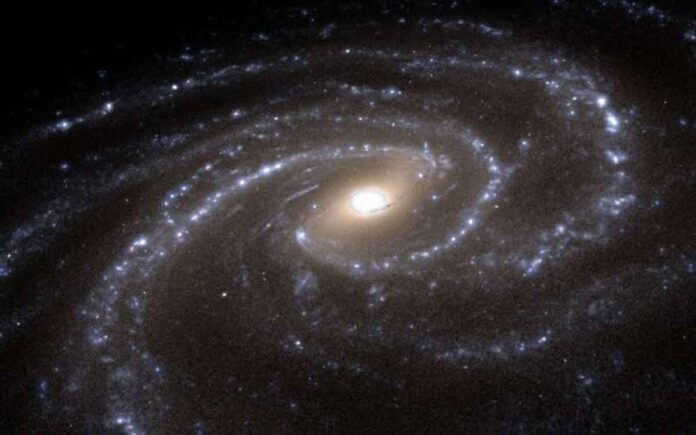A new simulation run on the world’s most powerful astronomy supercomputer has produced a testable scenario to explain the appearance of the Milky Way’s bar. The comparison of this scenario to data from current and future space telescopes will aid in the understanding of the evolution of our home galaxy.
The structure of the Milky Way galaxy is being revealed in greater detail by astronomy. Astronomers believe it is a disc galaxy with two- or four-armed spirals connected by a straight bar in the centre. They also know that the inner part of the bar has a peanut-shaped bulge, places where the bar is thicker, sticking out above and below the Milky Way galaxy’s mid plane, and a nuclear bulge, which is disk-like and located in the Milky Way’s centre. Some other galaxies, but not all, have two-type bulges.
Astronomers wondered, “How did the two-type bulges form?” To answer this question, a team led by Junichi Baba at the National Astronomical Observatory of Japan (NAOJ) used ATERUI II, the world’s most powerful supercomputer dedicated to astronomy, to simulate one possible scenario for a Milky Way-like galaxy. The team’s simulation is the most complete and accurate to date, taking into account not only stars but also interstellar gas. It also includes the formation of new stars from gas and the demise of stars as supernovae.
The formation of a bar aids in the channelling of gas into the galaxy’s core, where it triggers the formation of new stars. As a result, it may be reasonable to assume that the nuclear bugle in the galaxy is produced by new stars born there. However, simulations show that because the bar is so effective at channelling gas towards the centre, there are almost no new stars in the bar outside the nuclear bulge. This means that hogging out on gas isn’t the cause of a peanut-shaped bulge in the bar. Instead, the researchers discover that gravitational interactions can propel some of the stars into orbits above and below the midplane.
The simulation provides a testable scenario, which is the most exciting part. Because the peanut-shaped bulge does not acquire new stars, all of its stars must have existed prior to the formation of the bar. At the same time, the bar directs gas to the central region, where it produces a large number of new stars. As a result, almost all of the stars in the nuclear bulge were born after the bar formed. This implies that the stars in the peanut-shaped bulge will be older than the stars in the nuclear bulge, with a distinct age difference. This break corresponds to the formation of the bar.
Data from the European Space Agency’s Gaia probe and Japan’s future JASMINE satellite will allow us to calculate the motions and ages of stars and put this scenario to the test. If astronomers can detect a difference in the ages of stars in peanut-shaped and nuclear bulges, it will not only prove that overeating is not to blame for the peanut-shaped bulge, but it will also reveal the age of the Milky Way galaxy’s bar.
On March 8, 2022, Baba et al. published “Age distribution of stars in boxy/peanut/X-shaped bulges formed without bar buckling” in Monthly Notices of the Royal Astronomical Society.

